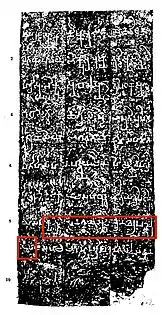Kharapallana (Brahmi: Kha-ra-pa-llā-na, Kharapallāna; Greek: Ancient Greek: Χαροβαλανο Kharobalano[1]) was an Indo-Scythian Northern Satrap who ruled around c. 130 CE.
Name
Kharapallana's name is attested in the Greek form Kharobalano (Ancient Greek: Χαροβαλανο)[1] and in the Brahmi form Kharapallāna, which are derived from the Saka name *Xāravalāna, meaning "splendid youth".[2]
Reign
He is mentioned as a "Great Satrap" (Brahmi:![]()
![]()
![]()
![]()
![]() , Mahakṣatrapa, "Great Satrap") of Kushan ruler Kanishka I on an inscription discovered in Sarnath, and dated to the 3rd year of Kanishka (c. 130 CE), in which Kanishka mentions he was, together with Satrap Vanaspara, governor of the eastern parts of his Empire.[3]
, Mahakṣatrapa, "Great Satrap") of Kushan ruler Kanishka I on an inscription discovered in Sarnath, and dated to the 3rd year of Kanishka (c. 130 CE), in which Kanishka mentions he was, together with Satrap Vanaspara, governor of the eastern parts of his Empire.[3]
The inscription was discovered on an early statue of a Boddhisattva, the Sarnath Bala Boddhisattva, now in the Sarnath Museum .[4]
Vanaspara and Kharapallana were ruling for Kanishka over the eastern provinces of the Empire, including the Benares region.[5]
References
- 1 2 Thomas, F.W. (1913). "The Date of Kanishka". The Journal of the Royal Asiatic Society of Great Britain and Ireland. 45 (3): 911–1042. doi:10.1017/S0035869X00045160. JSTOR 25189072. S2CID 162441696.
- ↑ Harmatta, János (1999). "Languages and scripts in Graeco-Bactria and the Saka Kingdoms". In Harmatta, János; Puri, B. N.; Etemadi, G. F. (eds.). History of civilizations of Central Asia. Vol. 2. Delhi: Motilal Banarsidass Publishing House. p. 412. ISBN 978-8-120-81408-0.
- ↑ Rapson, E. J. (1908). Catalogue of the Coins of the Andhra Dynasty, the Western Kṣatrapas, the Traikūṭaka Dynasty, and the "Bodhi" Dynasty. London: Longman & Co. p. ciii. ISBN 978-1-332-41465-9.
- ↑ Basham, A. L. (1968). Papers on the Date of Kaniṣka Submitted to the Conference on the Date of Kaniska, London, 20-22 April, 1960. E. J. Brill. p. 271. ISBN 978-90-04-00151-0.
- ↑ Sharma, R. S. (1991). Aspects of Political Ideas and Institutions in Ancient India. Delhi: Motilal Banarsidass Publishing House. p. 295. ISBN 9788120808270.

